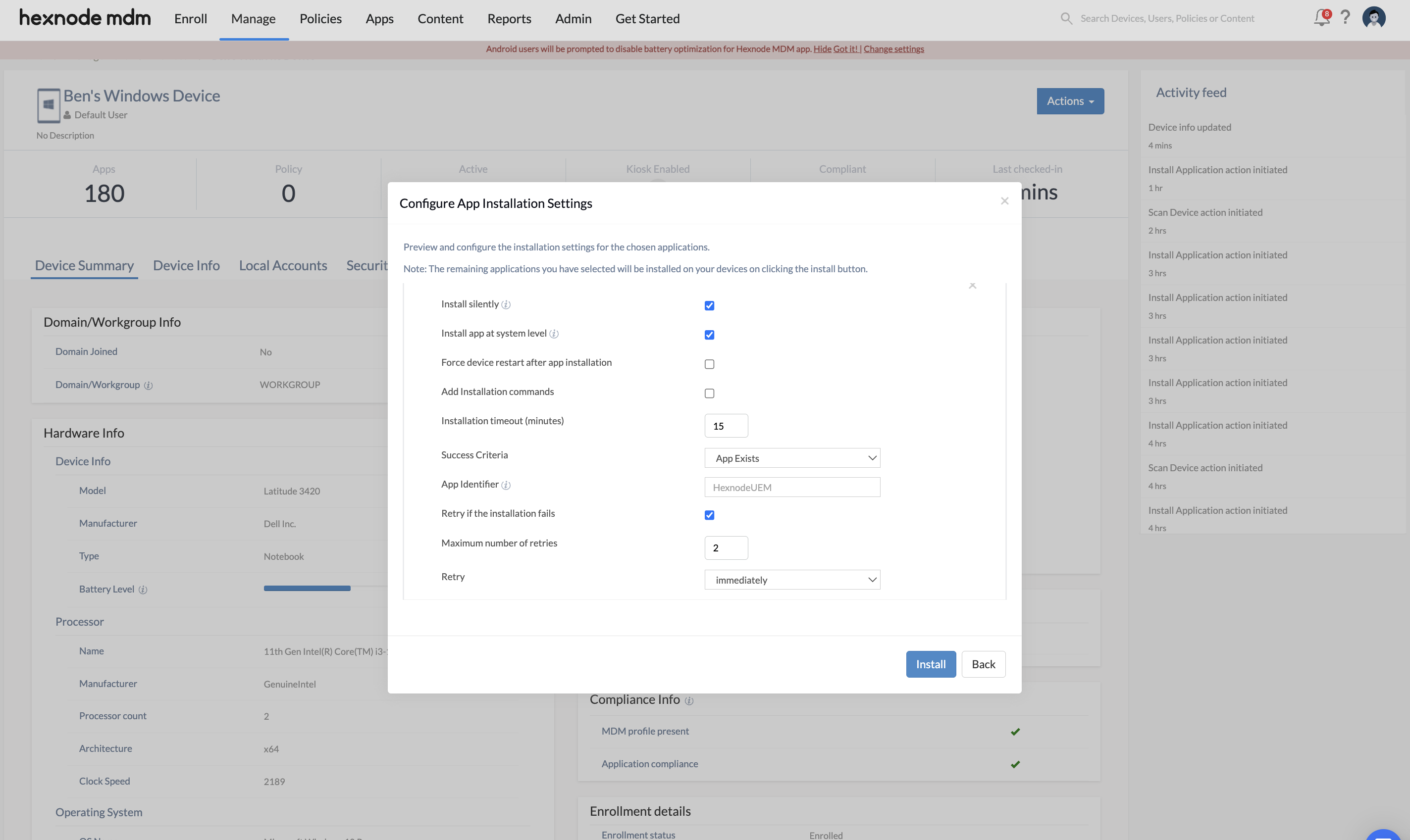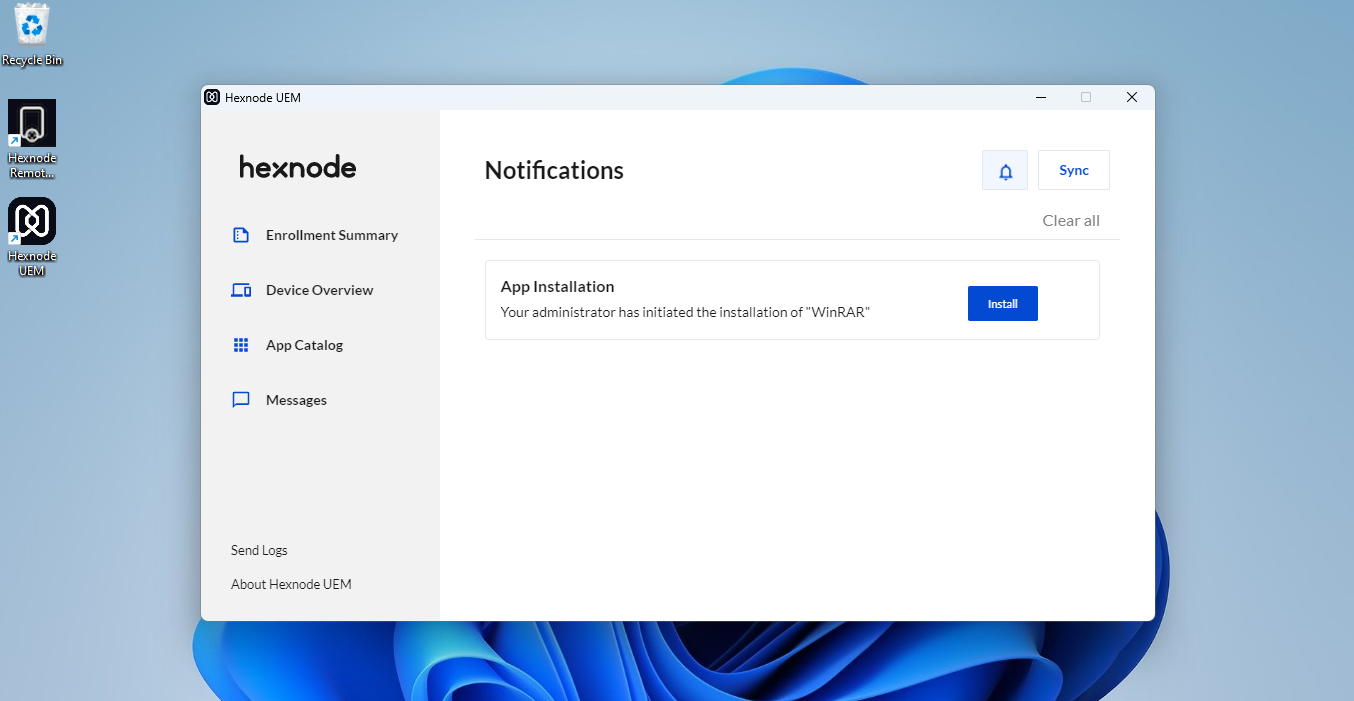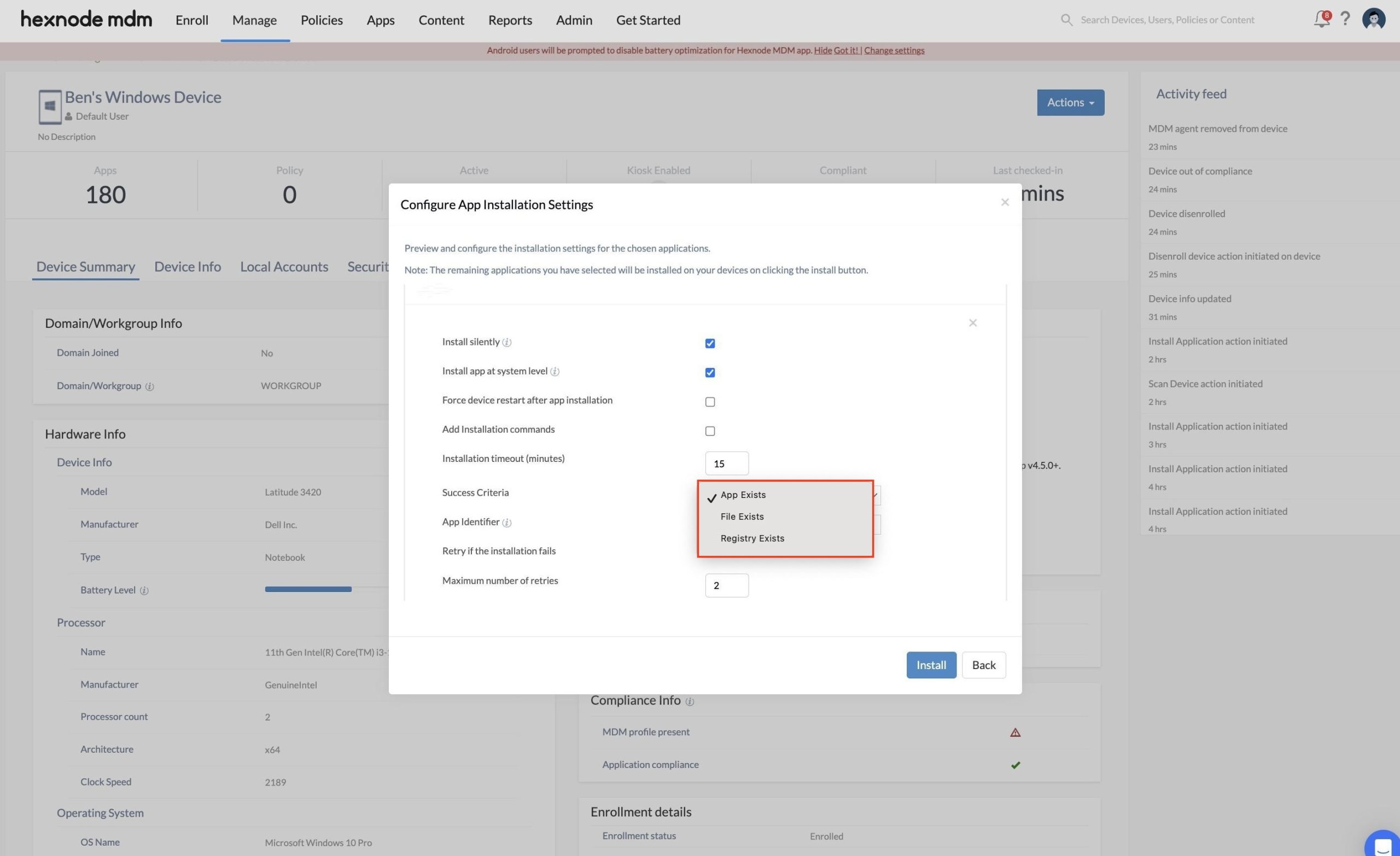Category filter
Deploy Windows EXE apps using Hexnode UEM
Microsoft has introduced the MSI (Microsoft Installer) format to streamline the deployment of enterprise software on Windows systems. However, it’s important to note that a substantial number of software publishers opt not to distribute MSI packages for their applications. Instead, they provide EXE (executable) files for installation on Windows devices. These applications encompass a wide variety, including in-house enterprise apps, utility apps, and various other software types. IT admins can now deploy EXE apps with the help of Hexnode UEM, and this help document explains the step-by-step guide on how to upload, configure, and deploy EXE apps on Windows devices.
Add EXE apps to Hexnode app inventory
An enterprise app must first be uploaded to the Hexnode app inventory before its distribution.
- Log in to your Hexnode UEM portal.
- Navigate to Apps.
- Select +Add Apps > Enterprise App.
- Choose the platform as Windows.
- Provide the App Name.
- Select the app category as EXE File.
- Select an app category or input a new category by clicking on the + button.
- Provide a description for the application and click Add to upload the file.
- While uploading the app file, you can check the Notify admin via email once app upload succeeds/fails option to receive the email notifications on the app upload status.
- Click Add to upload the file.
Deploy EXE apps via the Install Application action
The EXE apps added to the Hexnode app inventory can be distributed to the devices using the Install Application remote action. Follow the given steps for the deployment of EXE apps.
- On your Hexnode UEM portal, navigate to Manage > Devices.
- Click on the device.
- On the device summary page, click Actions > Install Application.
- Select the app.
- Click Configure to specify the installation settings.
- Click Install.
Configure EXE app installation settings
For EXE apps, Hexnode UEM enables administrators to configure various installation settings during app deployment.

- Install silently: The administrator can install apps silently on Windows devices with the help of this option. By default, this option is enabled, and it allows the installation of applications without prompting the user. If unchecked, the user will get a pop-up to allow the app installation manually.

If the user selects the Not Now option from the installation pop-up, then the app installation message will appear under the Notifications section of the Hexnode UEM app. Users can grant permission for installing the app from here in case they selected the Not Now option. This app installation prompt will appear under the Notifications section of the Hexnode UEM app only if the administrator checks the Retry if the installation fails option while configuring the app installation settings.

- Install app at system level: Installing an app at the system level refers to making the app available to all users of a computer, rather than just one user. By default, this option is checked. Unchecking this option will lead to the app installation at the currently logged-in user level only.
- Force device restart after app installation: When this option is selected, the device automatically restarts upon successful installation of apps.
- Add Installation commands: Admins can specify installation parameters by checking this option. These command-line parameters help admins modify the installation process and other related operations on the device.
- Installation timeout (minutes): If the app installation process is not complete within the specified time duration, it will be forcefully terminated. The minimum and maximum time duration is 10 and 60 minutes, respectively.
- Success Criteria: This option provides admins with the ability to define specific conditions that determine whether the EXE app installation is successful or not. There are three main sub-options available under this option.

- App Exists: Here, administrators can specify the App Identifier (product code) of the app. When specified, Hexnode will verify whether the given app is installed on the target device based on the product code provided.
The App Identifier may be a string of numbers or a name that is given by the app publisher like{56DDDFB8-7F79-4480-89D5-25E1F52AB28F}orHexnodeUEM.For example:
Successful Criteria - App ExistsApp Identifier - {56DDDFB8-7F79-4480-89D5-25E1F52AB28F} -
File Exists: By selecting this option, the administrator can verify the app’s installation on the device using a file present on the target device. The file path is specified in the Path field. This could be the path of any file that is created upon the successful installation of the app on the device.
For example:
Successful Criteria - File ExistsPath - C:\Hexnode\Hexnode UEM\Current\Hexnode UEM.exe -
Registry Exists: This option enables administrators to define the path of a registry key to be checked on the target device. This can be any registry key that is created when the app is successfully installed on the device.
The available registry file options are:
HKLM (HKEY_LOCAL_MACHINE)
HKCU (HKEY_CURRENT_USER)
HKCR (HKEY_CLASSES_ROOT)
HKCC (HKEY_CURRENT_CONFIG and
HKU (HKEY_USERS).For example:
Successful Criteria - Registry ExistsPath - \SOFTWARE\MyCompany\MyApplicationAfter the app deployment, administrators can verify the status of the Success Criteria from the Action History tab of the device from the Hexnode portal. Select the app installation status corresponding to the Install Application action initiated on the device to view it.

- Retry if the installation fails: This option allows the app installation process to automatically re-attempt if the initial installation attempt fails. The number of tries can be selected from the Maximum number of retries option. The minimum and maximum number of retries are 1 and 5 times, respectively.
- Retry: Administrators can specify when to retry the app installation process. The available options are:
- immediately
- after 1 minute
- after 2 minutes
- after 5 minutes
- after 10 minutes
- after 15 minutes
- after 30 minutes
- after 60 minutes
By following the steps mentioned in this help document, IT administrators can seamlessly add EXE apps to the Hexnode app inventory, customize various app installation settings to suit their organization’s requirements, and deploy these applications to devices with ease.


